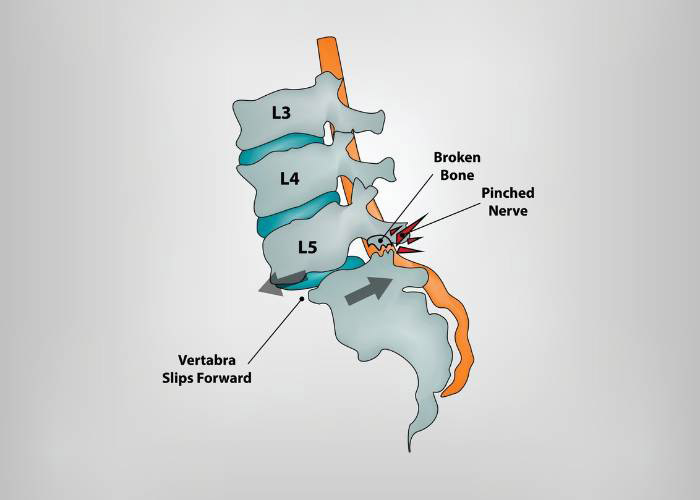Spondylolisthesis Specialist

Do you have lower back pain that worsens when standing, walking or bending forward? If so, you may have a condition called spondylolisthesis. Spondylolisthesis is a condition in the spine where the vertebrae slips out of position, onto the vertebrae below it, causing lower back pain. Spondylolisthesis specialist, Doctor Brenton Pennicooke, provides diagnosis as well as surgical and nonsurgical treatment options for patients in Saint Louis, Creve Coeur, and surrounding cities in St. Louis, St, Peters, Creve Coeur and surrounding cities in St. Louis county and St. Charles county, Missouri who are experiencing the symptoms of low back pain. Contact Dr. Pennicooke’s team today!
What is spondylolisthesis?
Spondylolisthesis (pronounced, spon-dee-low-lis-thee-sis) is a condition of the spine that causes lower back pain. It occurs when one of the vertebrae slips out of place (usually forward) onto the vertebra below. Sometimes this is caused by the discs between the vertebrae and the facet joints (located on the top and bottom of each vertebra) wearing down. The vertebra slips out of place and puts pressure on the neighboring nerves and nerve roots, which can cause pain. Often caused by spondylosis or arthritis and degenerative disease involving the spinal column, (link to article) spondylolisthesis can occur at any age. Spondylolisthesis specialists, Doctor Brenton Pennicooke, treats patients in St. Louis, St, Peters, Creve Coeur and surrounding cities in St. Louis county and St. Charles county, Missouri who are experiencing painful lower back symptoms associated with spondylolisthesis.

How is spondylolisthesis categorized?
Spondylolisthesis is categorized by doctors according to the degree the vertebrae has slipped:
- Low Grade: Less than half of the vertebrae has slipped forward onto the vertebrae below it. Low grade spondylolisthesis can be asymptomatic.
- High Grade: More than 50% of the width of the vertebrae slips forward onto the vertebrae below it. This can cause significant pain and nerve injury.
What causes spondylolisthesis?
Spondylolisthesis can have several different causes, most are attributed to overuse injuries in sports activities that require overstretching such as gymnastics, football, diving or weightlifting.
A specific type of spondylolisthesis, called spondylolysis, can result if there’s a defect in a specific part of the spinal column (called the pars), which causes the vertebral spillage to take place.
What are the symptoms of spondylolisthesis?
Spondylolisthesis can be asymptomatic for years before the condition is diagnosed. The most common symptoms include:
- Lower back pain
- Pain that worsens when standing or walking
- Pain that is alleviated when bending forward
- Pain that shoots into the buttocks and thighs
- Tight hamstring muscles
- Back stiffness
- Numbness or tingling that radiates down the lower back to the leg(s)
How is spondylolisthesis diagnosed?
Dr. Pennicooke will obtain a thorough history and a physical examination will be conducted. X-rays will show the condition and position of the vertebra and may show fractures or other bone issues. Specific x-rays with the patient flexing forward and extending backwards are obtain to evaluate if the spondylolisthesis has any movement or is “unstable.” A CT scan is often combined with x-rays to help see the degree of slippage and to plan treatment. Often an MRI is obtained, especially if the patient is having symptoms of numbness, pain, weakness or tingling in the extremities.
What are the treatment options for spondylolisthesis?
Spondylolisthesis that is not causing painful symptoms is treated with careful watching. If the patient is experiencing pain, Dr. Pennicooke will suggest conservative treatments before suggesting surgery.
Non-Surgical treatments:
Non-surgical, conservative therapies for spondylolisthesis may include pain relievers, such as NSAIDs (non-steroidal anti-inflammatory drugs) and ice and heat therapies. Discontinuing the activities that exacerbate the condition is also helpful, along with physical therapy. Sometimes bracing is needed to limit motion and allow the area to heal. Steroid injections have also been found to alleviate pain in the lower back as well as numbness and tingling in the legs.
Surgical treatment:
Patients with a history of long-term pain are not often suited for back-bracing and are better helped with surgical treatments. These may include one or more of the following:
- Decompression alone: This treatment relieves pressure on the nerves and nerve roots. However, is only commonly done in patient’s that have a stable spondylolisthesis.
- Fusion: Commonly used for this condition, especially if the spondylolisthesis is unstable on flexion-extension x-rays. A fusion permanently joins the vertebra together with special surgical rods, screws, and a bone graft.